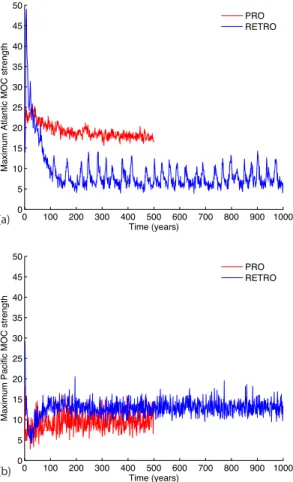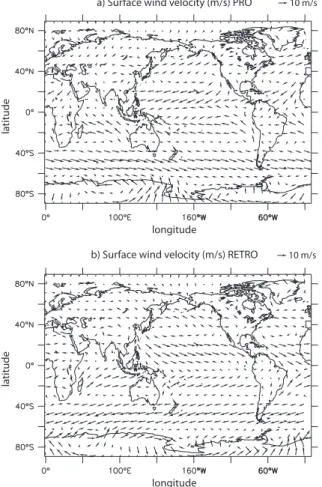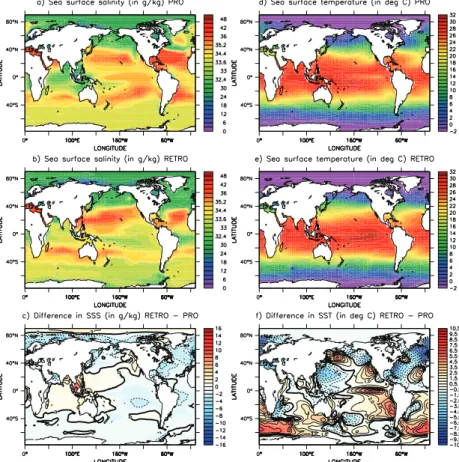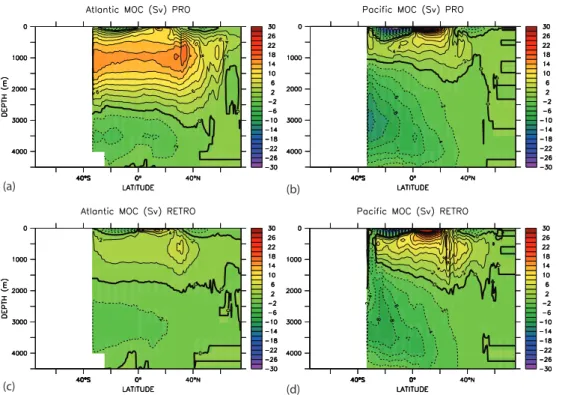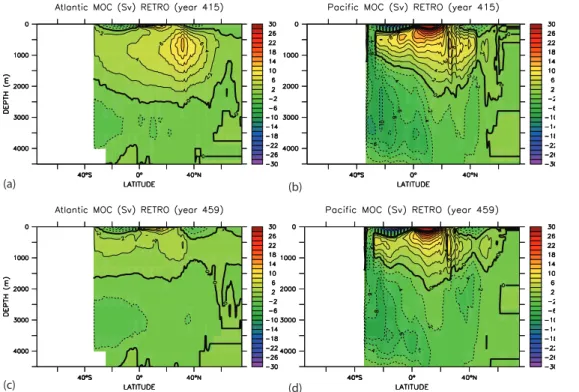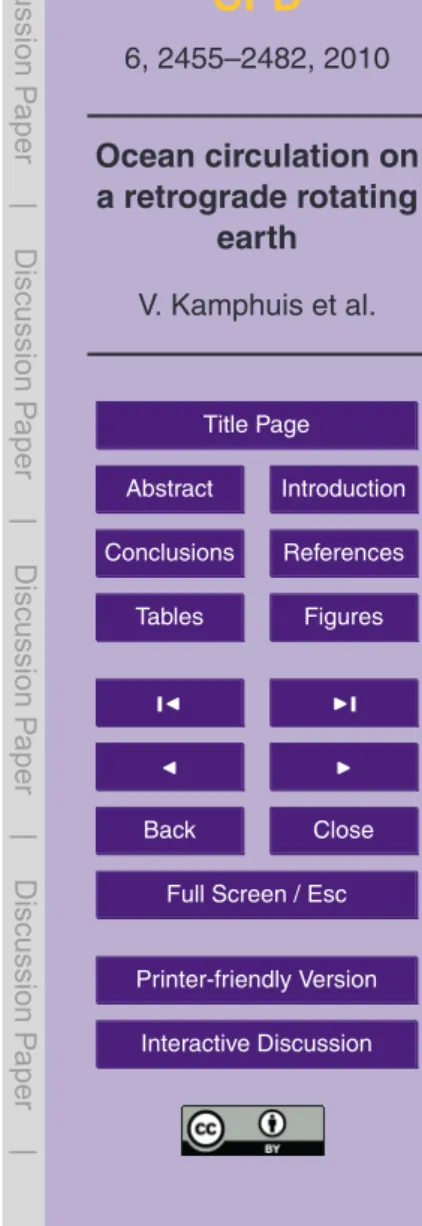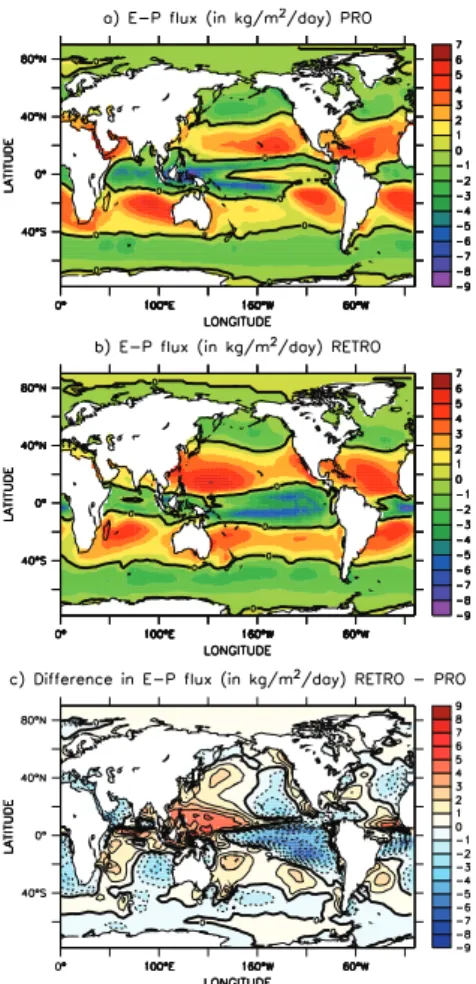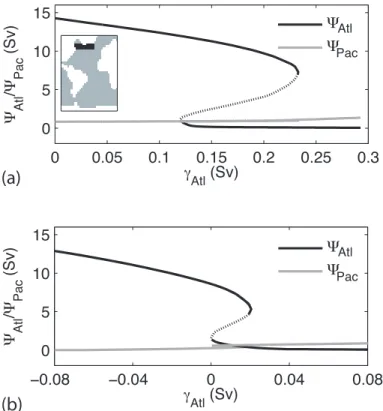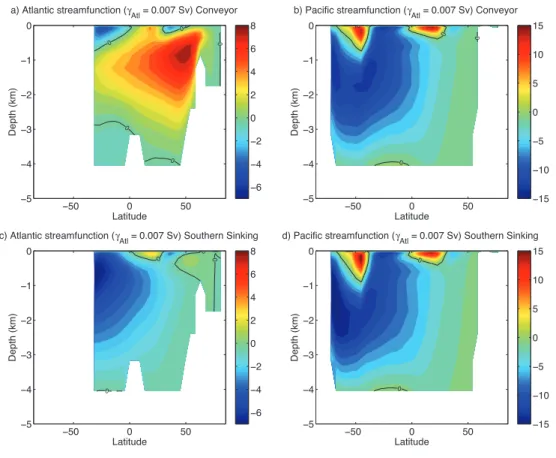CPD
6, 2455–2482, 2010Ocean circulation on a retrograde rotating
earth
V. Kamphuis et al.
Title Page
Abstract Introduction
Conclusions References
Tables Figures
◭ ◮
◭ ◮
Back Close
Full Screen / Esc
Printer-friendly Version Interactive Discussion
Discussion
P
a
per
|
Dis
cussion
P
a
per
|
Discussion
P
a
per
|
Discussio
n
P
a
per
Clim. Past Discuss., 6, 2455–2482, 2010 www.clim-past-discuss.net/6/2455/2010/ doi:10.5194/cpd-6-2455-2010
© Author(s) 2010. CC Attribution 3.0 License.
Climate of the Past Discussions
This discussion paper is/has been under review for the journal Climate of the Past (CP). Please refer to the corresponding final paper in CP if available.
The global ocean circulation on
a retrograde rotating earth
V. Kamphuis, S. E. Huisman, and H. A. Dijkstra
Institute for Marine and Atmospheric research Utrecht, Utrecht University, Utrecht, The Netherlands
Received: 3 September 2010 – Accepted: 22 October 2010 – Published: 3 November 2010
Correspondence to: S. E. Huisman (s.e.huisman@uu.nl)
CPD
6, 2455–2482, 2010Ocean circulation on a retrograde rotating
earth
V. Kamphuis et al.
Title Page
Abstract Introduction
Conclusions References
Tables Figures
◭ ◮
◭ ◮
Back Close
Full Screen / Esc
Printer-friendly Version Interactive Discussion
Discussion
P
a
per
|
Dis
cussion
P
a
per
|
Discussion
P
a
per
|
Discussio
n
P
a
per
|
Abstract
To understand the three-dimensional ocean circulation patterns that have occurred in past continental geometries, it is crucial to study the role of the present-day continen-tal geometry and surface (wind stress and buoyancy) forcing on the present-day global ocean circulation. This circulation, often referred to as the Conveyor state, is character-5
ized by an Atlantic Meridional Overturning Circulation (MOC) with deep water formation at northern latitudes and the absence of such deep water formation in the North Pa-cific. This MOC asymmetry is often attributed to the difference in surface freshwater flux: the North Atlantic is a basin with net evaporation, while the North Pacific receives net precipitation. This issue is revisited in this paper by considering the global ocean 10
circulation on a retrograde rotating earth, computing an equilibrium state of the coupled atmosphere-ocean-land surface-sea ice model CCSM3. The Atlantic-Pacific asymme-try in surface freshwater flux is indeed reversed but the ocean circulation pattern is not an Inverse Conveyor state (with deep water formation in the North Pacific) as there is strong and highly variable deep water formation in the North Atlantic. Using a fully-15
implicit, global ocean-only model also the stability properties of the Atlantic MOC on a retrograde rotating earth are investigated, showing a similar regime of multiple equilib-ria as in the present-day case. These results demonstrate that the present-day asym-metry in surface freshwater flux is not a crucial factor for the Atlantic-Pacific asymasym-metry in the global MOC.
20
1 Introduction
The extend and the connections between the main ocean basins have dramatically changed over the Cenozoic due to continental movement. Very likely, this has in-duced changes in the global ocean circulation pattern, in particular in the locations of deep-water formation. Indeed, there are many indications from various geological 25
CPD
6, 2455–2482, 2010Ocean circulation on a retrograde rotating
earth
V. Kamphuis et al.
Title Page
Abstract Introduction
Conclusions References
Tables Figures
◭ ◮
◭ ◮
Back Close
Full Screen / Esc
Printer-friendly Version Interactive Discussion
Discussion
P
a
per
|
Dis
cussion
P
a
per
|
Discussion
P
a
per
|
Discussio
n
P
a
per
or Miocene was substantially different from the present-day circulation (see von der Heydt and Dijkstra (2008) for an overview). An understanding of how factors such as continental geometry and surface forcing have affected these past circulation patterns requires a knowledge on why the present-day circulation is as we observe it.
At present, the global MOC is characterized by strong deep water formation in 5
the North Atlantic Ocean and the absence of deep water formation in the North Pa-cific Ocean. Near-surface currents transport water from the South Atlantic across the equator and into the subpolar North Atlantic. In this region, the relatively warm and saline water is cooled by heat loss to the cold atmosphere. In the Greenland and Labrador Seas, dense deep water is formed. This dense water is transported 10
back to the Southern Ocean in deep western boundary currents in the Atlantic Ocean. Eventually this deep water is returned to the surface by upwelling, which is driven by both mixing in the ocean’s interior and the westerly winds over the Southern Ocean (Kuhlbrodt et al., 2007). The Atlantic MOC is an important feature of the climate
system since it transports about 1 PW of heat (1 PW=1015W) northward at 25◦N
15
(Ganachaud and Wunsch, 2000).
The Atlantic-Pacific asymmetry in deep water formation is explained by the salinity contrast between the subpolar North Pacific and the subpolar North Atlantic: the sub-polar North Pacific surface water is not dense enough to sink, even when it is cooled to the freezing point. It is often argued that this salinity contrast is determined by the 20
observed difference in freshwater flux (E–P, i.e. net evaporation minus precipitation) between the North Pacific and the North Atlantic. This difference inE–P is mainly due to the higher evaporation rate per unit area over the North Atlantic as the precipitation rate per unit area has been estimated to be similar over the subpolar gyres (Emile-Geay et al., 2003). However, the higher evaporation rate over the North Atlantic is 25
CPD
6, 2455–2482, 2010Ocean circulation on a retrograde rotating
earth
V. Kamphuis et al.
Title Page
Abstract Introduction
Conclusions References
Tables Figures
◭ ◮
◭ ◮
Back Close
Full Screen / Esc
Printer-friendly Version Interactive Discussion
Discussion
P
a
per
|
Dis
cussion
P
a
per
|
Discussion
P
a
per
|
Discussio
n
P
a
per
|
Arguably, one of the main ingredients to answer this question is the strength of the salt-advection feedback (Stommel, 1961), through which salinity anomalies may be amplified. In short, an increase in the subpolar near-surface salinity enhances deep water formation. Therefore, the advection of salty subtropical water into the subpolar region is enhanced, further increasing the near-surface salinity in the regions of deep 5
water formation. There is also a negative temperature-advection feedback but as tem-perature anomalies are strongly damped by the overlying atmosphere compared to salinity anomalies, the salt-advection feedback can lead to relatively rapid changes of the MOC.
In a hierarchy of models, ranging from the two-box model of Stommel (1961) to 10
climate models of intermediate complexity (Rahmstorf et al., 2005), this salt-advection feedback creates a multiple equilibria regime of the MOC. In this multiple equilibrium regime, at least two stable states co-exist of the global MOC in realistic geometry: the Conveyor state (or “on”-state, with a vigorous Atlantic meridional overturning circulation and North Atlantic Deep Water formation) and a so-called Southern Sinking state (or 15
“off”-state) for which deep water formation only takes place in the Southern Ocean.
In the Conveyor state of this multiple equilibrium regime, the Atlantic MOC is self-sustaining, providing itself with the northward salt transport required for deep water formation. When the strength of the freshwater flux is varied over the northern North Atlantic, two saddle-node bifurcation points bound the region of the multiple and unique 20
state (either Conveyor or Southern Sinking) regimes (Dijkstra and Weijer, 2005), and abrupt transitions between these states can occur.
In an idealized ocean-only model of two (similar-size) basins which are connected by a channel at high southern latitudes, four different equilibrium solutions of the ocean circulation are found under an equatorially symmetric and zonally independent fresh-25
CPD
6, 2455–2482, 2010Ocean circulation on a retrograde rotating
earth
V. Kamphuis et al.
Title Page
Abstract Introduction
Conclusions References
Tables Figures
◭ ◮
◭ ◮
Back Close
Full Screen / Esc
Printer-friendly Version Interactive Discussion
Discussion
P
a
per
|
Dis
cussion
P
a
per
|
Discussion
P
a
per
|
Discussio
n
P
a
per
of these four states can no longer be maintained as steady states. For example, the impact of asymmetries on the steady-state patterns of the Atlantic MOC in a two-dimensional model (Dijkstra et al., 2003) has shown that a slight equatorial asymmetry
inE–P can lead to the disappearance of the Southern Sinking solution. The presence
of open gateways (von der Heydt and Dijkstra, 2008) or other geometrical asymme-5
tries, like a further northward extent of the Atlantic and a wider Pacific (Hughes and Weaver, 1994) have also been shown to lead to preference of specific solutions over others.
Hence at least two different views on the Atlantic-Pacific MOC asymmetry can be
proposed: 10
(i) The Atlantic-Pacific salinity contrast is set up mainly by external forcing asymme-tries (external meaning everything outside the ocean circulation itself, such as the asymmetry in surface freshwater flux) and multiple equilibria play no role.
(ii) Out of a number of possible equilibria, the present-day external asymmetries in-duce a strong preference for the Conveyor state.
15
The essential difference between these two views is the role of multiple equilibria and hence of the relative importance of the salt-advection feedback with respect to external forcing asymmetries in the global MOC.
Although it is difficult (if not impossible) to determine all MOC equilibria states in a state-of-the-art Global Climate Model (GCM), such as those used in the IPCC-AR4, 20
we can perform simulations with such a model to try falsify aspects of (i). One of the consequences of (i) is that if the external asymmetries are reversed (Atlantic versus Pacific), an Inverse Conveyor solution is expected. Using a global ocean-only model, Huisman et al. (2010b) determined an equilibrium state under a Levitus surface salinity field which is reversed between the Atlantic and the Pacific (the Pacific is made as 25
CPD
6, 2455–2482, 2010Ocean circulation on a retrograde rotating
earth
V. Kamphuis et al.
Title Page
Abstract Introduction
Conclusions References
Tables Figures
◭ ◮
◭ ◮
Back Close
Full Screen / Esc
Printer-friendly Version Interactive Discussion
Discussion
P
a
per
|
Dis
cussion
P
a
per
|
Discussion
P
a
per
|
Discussio
n
P
a
per
|
this is quite a contrived situation, it already shows that the asymmetries in the surface freshwater flux may not be crucial for the Atlantic-Pacific MOC asymmetry.
A nice way to generate different asymmetric surface freshwater flux forcing
con-ditions in a coupled ocean-atmosphere context is to investigate climate on an Earth which is rotating retrograde. The MOC on a retrograde rotating earth has been ex-5
amined before (Smith et al., 2008, EGU Poster) (although apparently never published) using the FAMOUS model, but not in the context of the problem of the Atlantic-Pacific MOC asymmetry. Interestingly, the basic mechanisms which control the MOC and the salt-advection feedback, are invariant to a reversal of the Earth’s direction of rotation.
Given a positive meridional density difference ∆ρ, the geostrophic and hydrostatic 10
balance give for the zonal velocityu,
f∂u ∂z
≈∆ρ
L (1)
where L is a typical horizontal basin length scale, f is the local Coriolis parameter
(f =2Ωsinθ) andzis the vertical coordinate. For a retrograde rotating earth, the zonal
surface velocity u is negative in the North Atlantic. Hence water will be transported
15
westwards at the surface providing a higher surface pressure in the west compared
to the east. A negative zonal pressure gradient ∆p/L will result and the meridional
velocityv is determined by
fv≈∆p
L (2)
Again in the North Atlantic, a positive v results which is similar to the response to
20
∆ρon a prograde rotating Earth. As the salt-advection feedback is associated with the meridional transport of salinity due to salinity perturbations which affect the MOC, it is also invariant with respect to a rotation reversal.
CPD
6, 2455–2482, 2010Ocean circulation on a retrograde rotating
earth
V. Kamphuis et al.
Title Page
Abstract Introduction
Conclusions References
Tables Figures
◭ ◮
◭ ◮
Back Close
Full Screen / Esc
Printer-friendly Version Interactive Discussion
Discussion
P
a
per
|
Dis
cussion
P
a
per
|
Discussion
P
a
per
|
Discussio
n
P
a
per
different. For example, the moisture transport by the trade winds over the Central Amer-ican isthmus is eastward on a retrograde rotating earth, salinifying the North Pacific and freshening the North Atlantic.
We therefore expect that the Atlantic-Pacific asymmetry in sea surface freshwater flux is reversed on a retrograde rotating earth and hence, under view (i) one would 5
expect an Inverse Conveyor state. So what looks like an academic exercise to investi-gate climate on a retrograde rotating earth may actually provide an interesting test for the falsification of view (i). In this paper we show results (Sect. 3) of the global MOC on a retrograde rotating earth using the coupled atmosphere-ocean-land surface-sea ice model CCSM3, which will be shortly described in Sect. 2. In addition, we analyze 10
the stability properties of the global MOC on a retrograde rotating earth in a global ocean-only model (Sect. 4). The results are summarized and discussed, in particular the implications for ocean circulation patterns in the past, in Sect. 5.
2 Model and experimental design
The climate of the Earth is simulated with the coupled atmosphere-ocean-land surface-15
sea ice model CCSM3 (Community Climate System Model, version 3, Collins et al., 2006a). The atmosphere component (CAM3, Collins et al., 2006b) has a horizontal T42 grid, which has a resolution of approximately 2.8◦
in both longitude and latitude, and 26 hybrid coordinate levels in the vertical. The ocean component is based on POP (Parallel Ocean Program, Smith and Gent, 2004). It has a curvilinear grid which 20
contains 100 longitudinal grid points (a resolution of 3.6◦
), 122 latitudinal grid points and 25 vertical levels. The sea ice is simulated in a thermodynamic sea-ice model (CSIM, Briegleb et al., 2004), which runs at the same resolution as the ocean model. The land component (CLM, Dickinson et al., 2006) runs at the same resolution as the atmospheric model. The CCSM3 model does not contain a dynamical vegetation 25
CPD
6, 2455–2482, 2010Ocean circulation on a retrograde rotating
earth
V. Kamphuis et al.
Title Page
Abstract Introduction
Conclusions References
Tables Figures
◭ ◮
◭ ◮
Back Close
Full Screen / Esc
Printer-friendly Version Interactive Discussion
Discussion
P
a
per
|
Dis
cussion
P
a
per
|
Discussion
P
a
per
|
Discussio
n
P
a
per
|
We performed a 500 year control simulation indicated by PRO (for prograde
rota-tion), with a CO2concentration of 355 ppmv (the observed global mean value in 1990)
and present-day boundary conditions. The initial ocean temperature and salinity for PRO were obtained from Levitus (1982). Both the maximum Atlantic and maximum Pacific MOC values are plotted versus time in Fig. 1. After 500 years of simulation, 5
the global meridional overturning circulation is in a stable quasi-equilibrium state. The global mean surface temperature equilibrates at 14.7◦
C, similar to earlier CCSM3 re-sults (Meehl et al., 2004).
In the second simulation with CCSM3, indicated by RETRO, only the sign of the
rotation rate Ω is switched from +1 to −1; a simulation of climate on a retrograde
10
rotating earth results. The initial temperature and salinity for RETRO are also obtained from Levitus (1982). The MOC is found to be in quasi-equilibrium after 500 model years (Fig. 1), but the simulation was continued for another 500 years, showing no apparent climate drift. In the next section, the quasi-stable equilibrium states after 500 years in PRO and RETRO (averages of years 400–500 of integration) will be compared. 15
3 The global MOC on a retrograde rotating earth
To illustrate one of the important consequences of a reversal of the Earth’s direction of rotation, the surface wind pattern for both PRO and RETRO is shown in Fig. 2. Be-cause the Coriolis acceleration changes direction and the equator to pole density gra-dient does not change, the thermal wind relations show that the wind patterns should 20
reverse. This is indeed the case in CCSM3 (Fig. 2b); the trade winds are eastward and the midlatitude winds are westward. The intensity of the wind velocity is similar for PRO and RETRO.
The sea surface salinity field and the sea surface temperature field for the PRO and RETRO quasi-equilibrium solutions are shown in Fig. 3. In the fields of PRO (Fig. 3a 25
CPD
6, 2455–2482, 2010Ocean circulation on a retrograde rotating
earth
V. Kamphuis et al.
Title Page
Abstract Introduction
Conclusions References
Tables Figures
◭ ◮
◭ ◮
Back Close
Full Screen / Esc
Printer-friendly Version Interactive Discussion
Discussion
P
a
per
|
Dis
cussion
P
a
per
|
Discussion
P
a
per
|
Discussio
n
P
a
per
western boundaries of the North Atlantic and the North Pacific are warmer and saltier than the eastern boundaries, because the western boundary currents (i.e. the Gulf stream in the North Atlantic and the Kuroshio in the North Pacific) transport warm and salty water from the subtropics northward. The more striking asymmetry exist between the two basins: the subpolar North Atlantic sea surface is warmer and saltier than the 5
subpolar North Pacific sea surface. This is related to the presence of the Conveyor state of the global MOC with a relatively strong Atlantic MOC (Fig. 1a) and a relatively weak Pacific MOC (Fig. 1b).
The midlatitude asymmetry in the sea surface salinity and sea surface temperature for RETRO (Fig. 3b and e) between the western and eastern boundaries of the basins 10
is reversed with respect to that in PRO. The main reason is that the midlatitude west-ern boundary currents in the ocean are located at the eastwest-ern basin boundaries on a retrograde rotating earth as the meridional derivative of the Coriolis parameter (theβ
parameter) has changed sign with respect to that in PRO. In the difference fields be-tween RETRO and PRO (Fig. 3c and f) these changes are seen as east-west dipoles 15
in the midlatitude basins. The subpolar North Atlantic sea surface in RETRO is both fresher and colder than in PRO, whereas the surface fields of the subpolar North Pacific in RETRO is saltier than in PRO.
As is shown in Fig. 4a, the Atlantic MOC in PRO has a maximum strength of about 18 Sv. The Pacific MOC (Fig. 4b) has a strength of about 7 Sv and is deeper and 20
stronger than estimates from observations, which is a known bias of CCSM3 (Thomp-son and Cheng, 2008). The Atlantic MOC in RETRO (shown in Fig. 4c) is considerably weaker than in PRO and has a maximum varying between 5 and 13 Sv on multidecadal timescales (Fig. 1a). The Pacific MOC in RETRO (Fig. 4d) has a maximum strength
of about 10 Sv, and this maximum occurs at about 25◦
N. Analysis of the mixed layer 25
depth (not shown) shows some deep convection at high northern latitudes and some convection at lower latitudes in the Pacific.
CPD
6, 2455–2482, 2010Ocean circulation on a retrograde rotating
earth
V. Kamphuis et al.
Title Page
Abstract Introduction
Conclusions References
Tables Figures
◭ ◮
◭ ◮
Back Close
Full Screen / Esc
Printer-friendly Version Interactive Discussion
Discussion
P
a
per
|
Dis
cussion
P
a
per
|
Discussion
P
a
per
|
Discussio
n
P
a
per
|
a substantial cooling of the subpolar North Atlantic sea surface. Consequently, on a retrograde rotating earth, surface temperatures over large parts of Europe are cooler
by as much as 10◦
C than in PRO and winter sea ice extends southward up to the Bay of Biscay. The increase in the southward extent of winter sea ice amplifies the cool-ing of the subpolar North Atlantic, as sea ice reflects more solar radiation than ocean 5
water.
When we take a closer look at this highly variable Atlantic MOC strength in RETRO (Fig. 1b), we find that it has an intermittent character, with short periods of vigorous overturning (Fig. 5a and b), alternated by periods with hardly any deep water formation (Fig. 5c and d). This is also visible in the mixed layer depth (not shown), which has 10
a maximum around the Southern tip of Greenland, 5 to 7 years prior to the maximum overturning. The timescale of the variablility is decadal and it is requires further study to understand why the amplitude of this decadal oscillation is so pronounced in RETRO.
The weakening of the Atlantic MOC can be expected to be caused by a freshening of the North Atlantic. At least part of the freshening can be explained by the increase 15
in stable precipitation (precipitation in convectively stable environments) over the mid-latitude North Atlantic (Fig. 6). Stable precipitation influences the freshwater flux at the sea surface and is, in contrast with evaporation and convective precipitation, for the most part independent of local sea surface temperatures and thereby the MOC itself. The increase in stable precipitation over the midlatitude North Atlantic freshens 20
the surface waters which are transported northward by the eastern boundary current. This results in a freshening of the subpolar North Atlantic. Other changes in climate aspects might also contribute to the freshening of the subpolar North Atlantic, including changes in interbasin salinity exchange via ocean pathways.
The surface freshwater flux (E–P), treated as a virtual salt flux and defined positive 25
CPD
6, 2455–2482, 2010Ocean circulation on a retrograde rotating
earth
V. Kamphuis et al.
Title Page
Abstract Introduction
Conclusions References
Tables Figures
◭ ◮
◭ ◮
Back Close
Full Screen / Esc
Printer-friendly Version Interactive Discussion
Discussion
P
a
per
|
Dis
cussion
P
a
per
|
Discussion
P
a
per
|
Discussio
n
P
a
per
and subpolar latitudes, the net flux over the North Atlantic is more salinifying than over the North Pacific. In the view of theory (i), this asymmetry has been suggested to determine the present-day state of the MOC, with deep water formation in the northern North Atlantic but not in the northern North Pacific. As expected, the asymmetry in the virtual salt flux field between the North Atlantic and the North Pacific is reversed (Fig. 5
7b) on a retrograde rotating earth (in RETRO). This is mainly due to changes in the freshwater flux in the North Pacific with more net evaporation in subtropical latitudes and less net precipitation in subpolar latitudes.
If the asymmetry in surface freshwater flux would determine the state of the MOC, i.e. view (i), we would expect to find an Inverse Conveyor, with deep water formation in 10
the North Pacific and not in the Atlantic, on a retrograde rotating earth. However, we find a state that has slightly stronger Pacific sinking compared to PRO, but still has a strong and highly variable Atlantic deep water formation.
4 Stability of the MOC on a retrograde rotating earth
With the CCSM3 simulation as in the previous section, we have obtained only one 15
quasi-equilibrium state of the global ocean circulation on a retrograde Earth. We would also like to compare the sensitivity of the global MOC to changes in the freshwater flux for the PRO and RETRO cases to see whether the salt-advection feedback is able to induce Inverse Conveyor states in the RETRO case. This analysis cannot be done with the CCSM3 and hence we use the mean forcing of the CCSM3 in an ocean-only 20
model.
4.1 Reference states in the ocean-only model
The ocean-only model used, is the fully-implicit ocean model from (Dijkstra and Wei-jer, 2005; Huisman et al., 2010a). The horizontal resolution of the model is about 4◦
CPD
6, 2455–2482, 2010Ocean circulation on a retrograde rotating
earth
V. Kamphuis et al.
Title Page
Abstract Introduction
Conclusions References
Tables Figures
◭ ◮
◭ ◮
Back Close
Full Screen / Esc
Printer-friendly Version Interactive Discussion
Discussion
P
a
per
|
Dis
cussion
P
a
per
|
Discussion
P
a
per
|
Discussio
n
P
a
per
|
grid has 12 non-equidistant levels in the vertical. Details of the model formulation are discussed in Dijkstra and Weijer (2005). The upper ocean is coupled to a sim-ple energy-balance atmospheric model (Dijkstra and Weijer, 2005, Appendix), in which only the heat transport is modelled (and no moisture transport). The special feature of this fully-implicit models is its ability to solve the steady model equations directly 5
without using any time-marching techniques, giving the true steady state (with zero model drift) of the system. An additional advantage of the steady state model is that full bifurcation diagrams can be calculated, including unstable steady states.
In the case PRO2, the ocean flow is forced by the annual-mean wind stress as given in Trenberth et al. (1989). The reference steady state is calculated by restoring the 10
model to the Levitus sea surface salinity field (Levitus, 1982). The reference steady state in PRO2 and its parameter settings are the same as in Huisman et al. (2010a). From this steady state, the freshwater flux is diagnosed, allowing us to change the surface freshwater flux under mixed boundary conditions.
The reference steady state in case RETRO2 is found by forcing the ocean surface 15
by the quasi-equilibrium surface wind stress field from the CCSM3 RETRO simulation and restoring the model to the quasi-equilibrium salinity field, also from RETRO. More specifically, a continuation path is followed under restoring boundary conditions, start-ing from the reference steady state in PRO2. First, the wind stress field at the ocean surface is reduced to zero. Secondly, we changed the rotation rate of the Earth from 20
Ω to −Ω. Then, we changed the zero wind stress field at the ocean surface to the
quasi-equilibrium wind stress field from RETRO, and the sea surface salinity field to the quasi-equilibrium sea surface salinity field from RETRO. Eventually, we diagnose the freshwater flux from this steady state. This specific path is followed because of the character of the fully-implicit model: equilibrium solutions can be found, provided that 25
CPD
6, 2455–2482, 2010Ocean circulation on a retrograde rotating
earth
V. Kamphuis et al.
Title Page
Abstract Introduction
Conclusions References
Tables Figures
◭ ◮
◭ ◮
Back Close
Full Screen / Esc
Printer-friendly Version Interactive Discussion
Discussion
P
a
per
|
Dis
cussion
P
a
per
|
Discussion
P
a
per
|
Discussio
n
P
a
per
4.2 North Atlantic freshwater flux perturbation
For both cases PRO2 and RETRO2, a bifurcation diagram with respect to a sub-polar North Atlantic freshwater flux perturbation is computed under mixed boundary conditions. For each case, the freshwater fluxFSis given by
FS=F d S+γAtlF
p
S−Q, (3)
5
whereFSd is, for each case, the freshwater flux diagnosed from the reference solution
andQ is a compensating term to ensure a net zero flux over the total ocean surface.
The parameterγAtl is the amplitude (in Sv) of the freshwater flux perturbation in the
North Atlantic over a domainFSpthat is unity in the area (φ,θ)∈[60◦W, 24◦W]×[54◦N, 66◦N] (Fig. 8a, inset), and zero elsewhere.
10
The bifurcation diagram for PRO2 (Fig. 8a), showing the maximum of the Atlantic and Pacific meridional overturning streamfunctions (ΨAtlandΨPac, respectively) versus the
parameterγAtl, is extensively described elsewhere (Dijkstra and Weijer, 2005; Huisman
et al., 2010a). The upper branch of the bifurcation diagram represents solutions with
an Atlantic MOC having deep water formation (Conveyor states). At γAtl=0.23 Sv
15
a saddle-node bifurcation point is reached; this is the threshold where the solution cannot sustain itself. The lower branch of solutions corresponds to stable steady states without NADW formation, in which deep water formation only takes place in the Southern Ocean (the Southern Sinking solution). A second saddle-node bifurca-tion (atγAtl=0.12 Sv) is related to the Atlantic MOC recovery. Between the two saddle
20
node bifurcation points, a multiple equilibria regime exists, in which both the Conveyor solution and the Southern Sinking solution exist. In this multiple equilibria regime, also a branch of unstable steady states exists, which cannot be found using a conventional time stepping model. Furthermore, we note that the Pacific MOC is hardly affected by the change inγAtl.
25
CPD
6, 2455–2482, 2010Ocean circulation on a retrograde rotating
earth
V. Kamphuis et al.
Title Page
Abstract Introduction
Conclusions References
Tables Figures
◭ ◮
◭ ◮
Back Close
Full Screen / Esc
Printer-friendly Version Interactive Discussion
Discussion
P
a
per
|
Dis
cussion
P
a
per
|
Discussion
P
a
per
|
Discussio
n
P
a
per
|
upper branch corresponds to the Conveyor solution, whereas the lower branch corre-sponds to the Southern Sinking solution. Furthermore, we can identify a multiple equi-libria regime which is bounded by two saddle-node bifurcation points (atγAtl≈ −10
−4
Sv
and γAtl=0.02 Sv). Because the subpolar North Atlantic is fresher in RETRO2, the
bifurcation diagram has shifted to the right, compared to the bifurcation diagram for 5
PRO2.
ForγAtl=0.007 Sv the Atlantic and Pacific MOC of the Conveyor state for the case RETRO2 are shown in Fig. 9a and b, respectively. The ocean circulation is in a weaker Conveyor state than in PRO2 for a similar value ofγAtl. The Atlantic MOC has a strength
of 8.0 Sv and there is no positive Pacific MOC. Likely due to the relatively large verti-10
cal mixing in the model there is enhanced upwelling within the Atlantic basin, which causes the absence of South Atlantic outflow. The reference steady state solution in
RETRO2 (forγAtl=0.0 Sv) has the same MOC patterns as in Fig. 9a–b and is close
to the saddle-node bifurcation point, which marks the transition to the Southern Sink-ing solution. Therefore, we find that both a Conveyor solution and a Southern SinkSink-ing 15
solution exist forγAtl=0.0 Sv in RETRO2. The meridional overturning streamfunctions
of the Atlantic and Pacific MOC of the Southern Sinking solution atγAtl=0.007 Sv are
shown in Fig. 9c, d. In this steady state, neither a positive Atlantic MOC nor a positive Pacific MOC is present.
5 Summary and discussion
20
In the present-day climate, the North Atlantic is a basin with net evaporation, while the North Pacific receives net precipitation. This argument is often used to explain the strong Atlantic-Pacific asymmetry in salinity and meridional overturning circulation, with deep water formation in the North Atlantic, but not in the North Pacific. Here, the ques-tion of why such a strong Atlantic-Pacific asymmetry exists has been investigated in an 25
CPD
6, 2455–2482, 2010Ocean circulation on a retrograde rotating
earth
V. Kamphuis et al.
Title Page
Abstract Introduction
Conclusions References
Tables Figures
◭ ◮
◭ ◮
Back Close
Full Screen / Esc
Printer-friendly Version Interactive Discussion
Discussion
P
a
per
|
Dis
cussion
P
a
per
|
Discussion
P
a
per
|
Discussio
n
P
a
per
The basic mechanism of the meridional flow response to a meridional density gradi-ent associated with the MOC is invariant to a reversal of the Earth’s direction of rotation. However, several other climate aspects which influence the MOC are not invariant. On a retrograde rotating earth, the midlatitude western boundary currents are relocated at the eastern basin boundaries. Furthermore, the salinity exchange via ocean pathways 5
and freshwater transport via the atmosphere differ on a retrograde rotating earth. Here, we focussed on the structure of the global MOC and its stability properties on a retrograde rotating earth. While the Atlantic-Pacific asymmetry inE–P is reversed with respect to the prograde rotating case due to changes in precipitation and evaporation patterns, we do not find a simple Inverse Conveyor solution (with deep water formation 10
limited to the North Pacific). Rather, we find a state with increased Pacific intermediate water formation and a weakened Atlantic MOC which is highly variable on decadal time scales and certainly still has northern deep water formation. The weakening of the Atlantic MOC is caused by the freshening of the North Atlantic and results in a substantial cooling of the subpolar North Atlantic sea surface. At least part of this 15
freshening can be explained by an increase in stable precipitation over the midlatitude North Atlantic due to a reversed atmospheric flow.
The stability properties of the global MOC on a retrograde rotating earth were ana-lyzed using a fully-implicit ocean-only model (Weijer et al., 2003; Dijkstra and Weijer, 2005; Huisman et al., 2010a) using the surface wind stress field and sea surface salin-20
ity field from the CCSM3 quasi-equilibrium solution to determine a reference state. The response of the MOC on a retrograde rotating earth to freshwater perturbations in the subpolar North Atlantic surface freshwater flux is similar to the response of the MOC in our present-day climate. The bifurcation diagram has a similar shape and contains a multiple equilibria regime for a range of subpolar North Atlantic freshwater 25
CPD
6, 2455–2482, 2010Ocean circulation on a retrograde rotating
earth
V. Kamphuis et al.
Title Page
Abstract Introduction
Conclusions References
Tables Figures
◭ ◮
◭ ◮
Back Close
Full Screen / Esc
Printer-friendly Version Interactive Discussion
Discussion
P
a
per
|
Dis
cussion
P
a
per
|
Discussion
P
a
per
|
Discussio
n
P
a
per
|
Based on the results of the CCSM3 and the ocean-only model, we conclude that
even when the forcing of the freshwater flux (E–P) is reversed between North
At-lantic and North Pacific, a global MOC with North AtAt-lantic deep water formation hav-ing similar stability properties as the global MOC on the prograde rotathav-ing Earth still exists. This suggests that solely the external surface forcing of the ocean circula-5
tion is not the dominant factor in setting the large salinity difference and ocean cir-culation asymmetry between the Atlantic and Pacific basin. We do not claim that we have falsified the view (i) as presented in the introduction, but we certainly found re-sults (in agreement with those in Huisman et al., 2010b) which do not fit within view
(i). Under a reversed freshwater flux, one would expect to find a clear Inverse
10
Conveyor solution.
As the external forcing appears not capable of generating the present-day Atlantic-Pacific MOC asymmetry, the origin of this asymmetry may be associated with the selec-tion of the Conveyor state due to external factors according to the view (ii) in the intro-duction. There is many partial results (Hughes and Weaver, 1994; Dijkstra et al., 2003; 15
von der Heydt and Dijkstra, 2008; Czaja, 2009) on which factors favor the selection of this state (such as basin size, land-sea contrast, gateway transports, atmospheric circulation, etc.), but all of studies have been done with rather idealized models. It is, however, clear from these studies (Dijkstra et al., 2003) that external asymmetries can have quite some more consequences on the existence regime of one type of solution 20
(for example a Southern Sinking solution), than on existence regime of another type (like a Conveyor solution).
The view above implies that continental geometry is a crucial factor for selection of global ocean circulation patterns. As a consequence, the equilibrium ocean cir-culation pattern under past continental geometries such as in the Eocene, Oligocene 25
or Miocene may depend on subtle differences in the continental geometry of ocean
CPD
6, 2455–2482, 2010Ocean circulation on a retrograde rotating
earth
V. Kamphuis et al.
Title Page
Abstract Introduction
Conclusions References
Tables Figures
◭ ◮
◭ ◮
Back Close
Full Screen / Esc
Printer-friendly Version Interactive Discussion
Discussion
P
a
per
|
Dis
cussion
P
a
per
|
Discussion
P
a
per
|
Discussio
n
P
a
per
robustness of the global ocean circulation pattern, and associated meridional heat transport, found in GCMs.
It will be difficult to find support for the view (ii) using present-day simulations in state-of-the-art GCMs as the global Conveyor state may already be unique (due to the external asymmetries all other equilibria do not exist any more). Rather artificial 5
studies would be needed where, for example, the continents are more symmetrized with respect to reality and even then, one probably would have to be lucky to find other equilibria than the Conveyor state. Results from paleoclimate modeling studies, where continents have very different positions, may also provide support for the view (ii) although there are no results yet of multiple MOC equilibria in any paleogeography yet. 10
One would be able to tackle the problem systematically when techniques of numerical bifurcation could be applied to full climate models, but that will take considerable time. In summary, in answering our question from the introduction on why there is a strong present-day Atlantic-Pacific MOC asymmetry we established that view (i) likely is not correct. However, to obtain convincing support for view (ii) creative model experiments 15
are needed.
Acknowledgements. We thank Michael Kliphuis (IMAU) for technical support. The CCSM3 computations were done on the Huygens IBM Power6 Supercomputer (Huygens) at SARA in Amsterdam. Use of these computing facilities was sponsored by the National Computing Facili-ties Foundation (N.C.F.) under the project SH084-08 with financial support from the Netherlands
20
Organization for Scientific Research (N.W.O.).
References
Briegleb, B., Bitz, C., Hunke, E., Lipscomb, W., Holland, M., Schramm, J., and Moritz, R.: Scientific description of the sea ice component in the Community Climate System Model, Version 3, Tech. note tn-463+str, National Center for Atmospheric Research, Boulder, CO,
25
1, 70 pp., 2004. 2461
CPD
6, 2455–2482, 2010Ocean circulation on a retrograde rotating
earth
V. Kamphuis et al.
Title Page
Abstract Introduction
Conclusions References
Tables Figures
◭ ◮
◭ ◮
Back Close
Full Screen / Esc
Printer-friendly Version Interactive Discussion
Discussion
P
a
per
|
Dis
cussion
P
a
per
|
Discussion
P
a
per
|
Discussio
n
P
a
per
|
Santer, B. D., and Smith, R. D.: The Community Climate System Model Version 3 (CCSM3), J. Climate, 19, 2122–2143, 2006a. 2461, 2468
Collins, W. D., Rasch, P. J., Boville, B. A., Hack, J. J., McCaa, J. R., Williamson, D. L., Briegleb, B. P., Bitz, C. M., Lin, S.-J., and Zhang, M.: The Formulation and Atmospheric Simulation of the Community Atmosphere Model Version 3 (CAM3), J. Climate, 19, 2144–2161, 2006b.
5
2461
Czaja, A.: On the driving processes of the Atlantic meridional overturning circulation, J. Phys. Oceanogr., 39, 234–247, 2009. 2470
Dickinson, R. E., Oleson, K. W., Bonan, G., Thornton, P., Vertenstein, M., Hoffman, F., Yang, Z.-L., and Zeng, X.: The Community Land Model and Its Climate Statistics as a Component
10
of the Community Climate System Model, J. Climate, 19, 2302–2324, 2006. 2461
Dijkstra, H. A. and Weijer, W.: Stability of the global ocean circulation: Basic bifurcation dia-grams, J. Phys. Oceanogr., 35, 933–948, 2005. 2458, 2465, 2466, 2467, 2469
Dijkstra, H. A., Weijer, W., and Neelin, J. D.: Imperfections of the three-dimensional thermoha-line ocean circulation: hysteresis and unique state regimes, J. Phys. Oceanogr., 33, 2796–
15
2814, 2003. 2459, 2470
Emile-Geay, J., Cane, M. A., Naik, N., Seager, R., Clement, A. C., and van Geen, A.: Warren revisited: atmospheric freshwater fluxes and “Why is no deep water formed in the North Pacific”, J. Geophys. Res., 108(C6), 3178, doi:10.1029/2001JC001058, 2003. 2457
Ganachaud, A. and Wunsch, C.: Improved estimates of global ocean circulation, heat transport
20
and mixing from hydrographic data, Nature, 408, 453–457, 2000. 2457
Hughes, T. M. C. and Weaver, A. J.: Multiple Equilibria of an Asymmetric Two-Basin Ocean Model, J. Phys. Oceanogr., 24, 619–637, 1994. 2459, 2470
Huisman, S. E., Dijkstra, H. A., von der Heydt, A., and de Ruijter, W. P. M.: Robustness of Multiple Equilibria in the global ocean circulation, Geophys. Res. Lett., 36, L01610,
25
doi:10.1029/2008GL036322, 2009. 2458
Huisman, S. E., den Toom, M., Dijkstra, H. A., and Drijfhout, S.: An Indicator of the Multiple Equilibria Regime of the Atlantic Meridional Overturning Circulation, J. Phys. Oceanogr., 40, 551–567, 2010a. 2465, 2466, 2467, 2469
Huisman, S. E., Dijkstra, H. A., von der Heydt, A., and de Ruijter, W. P. M.: Does netE–P
deter-30
mine the preference for Atlantic sinking?, http://www.phys.uu.nl/∼shuisman/JPOsubmitted/, submitted, 2010b. 2459, 2470
CPD
6, 2455–2482, 2010Ocean circulation on a retrograde rotating
earth
V. Kamphuis et al.
Title Page
Abstract Introduction
Conclusions References
Tables Figures
◭ ◮
◭ ◮
Back Close
Full Screen / Esc
Printer-friendly Version Interactive Discussion
Discussion
P
a
per
|
Dis
cussion
P
a
per
|
Discussion
P
a
per
|
Discussio
n
P
a
per
the driving processes of the Atlantic meridional overturning circulation, Rev. Geophys., 45, RG2001, doi:10.1029/2004RG000166, 2007. 2457
Levitus, S.: Climatological Atlas of the World Ocean, NOAA Professional Paper, 1982. 2462, 2466
Marotzke, J. and Willebrand, J.: Multiple equilibria of the global thermohaline circulation, J.
5
Phys. Oceanogr., 21, 1372–1385, 1991. 2458
Meehl, G. A., Washington, W. M., Arblaster, J. M., and Hu, A.: Factors affecting climate sensi-tivity in global coupled models, J. Climate, 17, 1584–1596, 2004. 2462
Rahmstorf, S., Crucifix, M., Ganopolski, A., Goosse, H., Kamenkovich, I., Knutti, R., Lohmann, G., Marsh, R., Mysak, L. A., Wang, Z., and Weaver, A. J.: Thermohaline circulation
hystere-10
sis: a model intercomparison, Geophys. Res. Lett., 32, L23605, doi:10.1029/2005GL023655, 2005. 2458
Smith, R. and Gent, P.: Reference manual for the Parallel Ocean Program (POP): Ocean com-ponent of the Community Climate System Model (CCSM2.0 and 3.0), Tech. rep. laur-02-2484, Los Alamos National Laboratory, Los Alamos, NM, 75 pp., 2004. 2461
15
Smith, R. S., Gregory, J. M., Thorpe, R. B., and Rodriguez, J.: Response of the meridional overturning circulation in an idealised reverse world experiment, EGU General Assembly, session CL26 poster; Ref. No.: EGU2008-A-06893, 2008. 2460
Stommel, H.: Thermohaline convection with two stable regimes of flow, Tellus, 13, 224–230, 1961. 2458
20
Thompson, L. A. and Cheng, W.: Water Masses in the Pacific in CCSM3, J. Climate, 21, 4514– 4528, 2008. 2463
Trenberth, K. E., Olson, J. G., and Large, W. G.: A global ocean wind stress climatology based on ECMWF analyses, Tech. rep., National Center for Atmospheric Research, Boulder, CO, USA, 1989. 2466
25
von der Heydt, A. and Dijkstra, H. A.: The effect of gateways on ocean circulation patterns in the Cenozoic, Glob. Planet Change, 62, 132–146, 2008. 2457, 2459, 2470
Weijer, W., Dijkstra, H. A., ¨Oks ¨uzoglu, H., Wubs, F. W., and de Niet, A. C.: A fully-implicit model of the global ocean circulation, J. Comput. Phys., 192, 452–470, 2003. 2469
Zaucker, F., Stocker, T. F., and Broecker, W. S.: Atmospheric freshwater flux and their
30
CPD
6, 2455–2482, 2010Ocean circulation on a retrograde rotating
earth
V. Kamphuis et al.
Title Page
Abstract Introduction
Conclusions References
Tables Figures
◭ ◮
◭ ◮
Back Close
Full Screen / Esc
Printer-friendly Version Interactive Discussion
Discussion
P
a
per
|
Dis
cussion
P
a
per
|
Discussion
P
a
per
|
Discussio
n
P
a
per
|
0 100 200 300 400 500 600 700 800 900 1000 0
5 10 15 20 25 30 35 40 45 50
Time (years)
Maximum Atlantic MOC strength
PRO RETRO
0 100 200 300 400 500 600 700 800 900 1000 0
5 10 15 20 25 30 35 40 45 50
Time (years)
Maximum Pacific MOC strength
PRO RETRO
(a)
(b)
Fig. 1. The strength (in Sv) of the(a)maximum Atlantic and(b)maximum Pacific meridional
CPD
6, 2455–2482, 2010Ocean circulation on a retrograde rotating
earth
V. Kamphuis et al.
Title Page
Abstract Introduction
Conclusions References
Tables Figures
◭ ◮
◭ ◮
Back Close
Full Screen / Esc
Printer-friendly Version Interactive Discussion
Discussion
P
a
per
|
Dis
cussion
P
a
per
|
Discussion
P
a
per
|
Discussio
n
P
a
per
a) Surface wind velocity (m/s) PRO
b) Surface wind velocity (m/s) RETRO longitude
longitude
la
titude
la
titude
10 m/s 10 m/s
Fig. 2. Surface wind field (m/s) in(a) PRO and(b)RETRO. The reversal of the surface wind
CPD
6, 2455–2482, 2010Ocean circulation on a retrograde rotating
earth
V. Kamphuis et al.
Title Page
Abstract Introduction
Conclusions References
Tables Figures
◭ ◮
◭ ◮
Back Close
Full Screen / Esc
Printer-friendly Version Interactive Discussion
Discussion
P
a
per
|
Dis
cussion
P
a
per
|
Discussion
P
a
per
|
Discussio
n
P
a
per
|
Fig. 3.Sea surface salinity (SSS, g/kg) and sea surface temperature (SST,◦
C). SSS of(a)PRO;
CPD
6, 2455–2482, 2010Ocean circulation on a retrograde rotating
earth
V. Kamphuis et al.
Title Page
Abstract Introduction
Conclusions References
Tables Figures
◭ ◮
◭ ◮
Back Close
Full Screen / Esc
Printer-friendly Version Interactive Discussion
Discussion
P
a
per
|
Dis
cussion
P
a
per
|
Discussion
P
a
per
|
Discussio
n
P
a
per
(a) (b)
(c) (d)
Fig. 4. Meridional overturning streamfunctions (in Sv) in the Atlantic(a)and the Pacific(b)in
CPD
6, 2455–2482, 2010Ocean circulation on a retrograde rotating
earth
V. Kamphuis et al.
Title Page
Abstract Introduction
Conclusions References
Tables Figures
◭ ◮
◭ ◮
Back Close
Full Screen / Esc
Printer-friendly Version Interactive Discussion
Discussion
P
a
per
|
Dis
cussion
P
a
per
|
Discussion
P
a
per
|
Discussio
n
P
a
per
|
(a) (b)
(c) (d)
Fig. 5. Meridional overturning streamfunctions (in Sv) in the Atlantic and the Pacific. (a, b)
CPD
6, 2455–2482, 2010Ocean circulation on a retrograde rotating
earth
V. Kamphuis et al.
Title Page
Abstract Introduction
Conclusions References
Tables Figures
◭ ◮
◭ ◮
Back Close
Full Screen / Esc
Printer-friendly Version Interactive Discussion
Discussion
P
a
per
|
Dis
cussion
P
a
per
|
Discussion
P
a
per
|
Discussio
n
P
a
per
Fig. 6.Stable (non convective) precipitation (SP) in mm/day in(a)PRO;(b)RETRO and(c)the
CPD
6, 2455–2482, 2010Ocean circulation on a retrograde rotating
earth
V. Kamphuis et al.
Title Page
Abstract Introduction
Conclusions References
Tables Figures
◭ ◮
◭ ◮
Back Close
Full Screen / Esc
Printer-friendly Version Interactive Discussion
Discussion
P
a
per
|
Dis
cussion
P
a
per
|
Discussion
P
a
per
|
Discussio
n
P
a
per
|
Fig. 7.The virtual salt flux (in kg/m2/day), corresponding with the surface freshwater fluxE–P,
CPD
6, 2455–2482, 2010Ocean circulation on a retrograde rotating
earth
V. Kamphuis et al.
Title Page
Abstract Introduction
Conclusions References
Tables Figures
◭ ◮
◭ ◮
Back Close
Full Screen / Esc
Printer-friendly Version Interactive Discussion
Discussion
P
a
per
|
Dis
cussion
P
a
per
|
Discussion
P
a
per
|
Discussio
n
P
a
per
0 0.05 0. 1 0.15 0.2 0.25 0. 3 0
5 10 15
Ψ At
l
/
Ψ Pa
c
(Sv)
γAtl (Sv)
ΨAtl ΨPac
−0.08 −0.04 0 0.04 0.08 0
5 10 15
Ψ At
l
/
Ψ Pa
c
(Sv)
γAtl (Sv)
ΨAtl ΨPac
(a)
(b)
Fig. 8. Bifurcation diagrams under mixed boundary conditions, in which the maximum value
of the meridional overturning streamfunction in the Atlantic (ΨAtl, black lines) and the Pacific
(ΨPac, grey lines) are plotted versus the amplitude of the subpolar North Atlantic and subpolar
North Pacific freshwater forcing,γAtl. In(a),ΨAtlandΨPacare shown versusγAtlfor PRO2. The
indent shows the area where the perturbation freshwater flux is applied. In(b),ΨAtl andΨPac
are shown versusγAtlfor RETRO2. The range for which multiple equilibria exist is much smaller
than in PRO2 and is shifted towards smaller values of γAtl, but the shape of the bifurcation
CPD
6, 2455–2482, 2010Ocean circulation on a retrograde rotating
earth
V. Kamphuis et al.
Title Page Abstract Introduction Conclusions References Tables Figures ◭ ◮ ◭ ◮ Back Close
Full Screen / Esc
Printer-friendly Version Interactive Discussion Discussion P a per | Dis cussion P a per | Discussion P a per | Discussio n P a per | Latitude D e p th (km)
a) Atlantic streamfunction (γAtl = 0.007 Sv) Conveyor
0
0
0
0
0
−50 0 50
−5 −4 −3 −2 −1 0 −6 −4 −2 0 2 4 6 8 Latitude D e p th (km)
b) Pacific streamfunction (γAtl = 0.007 Sv) Conveyor
0
0
0
0
−50 0 50
−5 −4 −3 −2 −1 0 −15 −10 −5 0 5 10 15 Latitude D e p th (km)
c) Atlantic streamfunction (γAtl = 0.007 Sv) Southern Sinking
0
0
0
0
−50 0 50
−5 −4 −3 −2 −1 0 −6 −4 −2 0 2 4 6 8 Latitude D e p th (km)
d) Pacific streamfunction (γAtl = 0.007 Sv) Southern Sinking
0
0 0
−50 0 50
−5 −4 −3 −2 −1 0 −15 −10 −5 0 5 10 15
Fig. 9.Atlantic and Pacific meridional overturning streamfunctions in case RETRO2. Because
